Sculptures
- Introduction
- 1947: Colt Pegasus
- 1976: Saints and Sinners
- 1977: Zee
- 1981: Sunset Cube
- 1981: Day Star
- 1981: Rhythm and Variations
- 1981: Untitled by Tom Bills
- 1981: Telegraph Exchange
- 1981: Untitled by Mel Leiserowitz
- 1988: Motherswell
- 1994: The Burghers
- 1994: Structurist Sculpture No.11
- 1999: Echo Cognitio
- 2002: Resound
- 2006: The Grizz
- The Meadow Brook Invitational: Outdoor Sculpture Competition (1980)
- 2018: Matilda Dodge Wilson
Introduction
The campus of Oakland University boasts a number of outdoor sculptures by well-known artists, most of them with local roots. The Saints and Sinners fountain was the first one in 1976. In 1981, an outdoor sculpture competition -- called The Invitational -- led to the establishment of six sculptures on the eastern side of campus. A recent addition, The Grizz, is the mascot of the university. In 2018, a statue of Matilda Dodge Wilson was erected by South Foundation Hall.
Those outdoor sculptures have impacted the physical landscape shared by students, scholars, and the surrounding community. Their installation on campus has been made possible through relationships between donors, artists and members of Oakland University's administration and staff.
----
Credits for this exhibit:
Original research and writing: Audra Pieknik-Shewell
for an internship during the summer of 2010. Special thanks to Jacky Leow, Oakland University Art Gallery Assistant and Professor Goody, Curator of Oakland University Art Gallery for their assistance with this project.
Original web pages: Linda Hildebrand
Updated with additional research by Dominique Daniel, 02/15/2014
Colt Pegasus
Avard T. Fairbanks
Bronze
1947
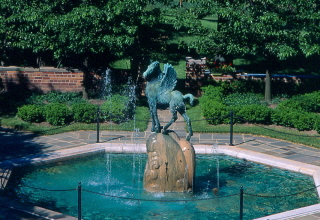
The Colt Pegasus Fountain is the centerpiece of the Breakfast Gardens at Meadow Brook Hall. It was the work of renowned sculptor Avard T. Fairbanks. Matilda Wilson commissioned it to be cast in bronze and installed in the middle of a fountain.1
Avard Fairbanks was a prolific sculptor who taught at the University of Michigan from 1929 to 1947 and made numerous local contributions.
He was born in 1897 in Utah, the tenth of eleven children. His father was an muralist. When his father moved to New York City, Avard followed and at a young age, he was copying sculpture at the Metropolitan Museum of Art and modelling animals at the Bronx. His formal education began in 1913 at the Ecole Nationale des Beaux Arts in Paris, France, but the onset of the Great War made it imperative for him to return home. He went to Hawaii to help one of his older brothers on a commission and after his return in 1917, he entered the University of Utah. After completing his studies in 1920 he was offered a position at the University of Oregon to teach sculpture. He attended Yale University in 1924 and was awarded a B.F.A. during a leave of absence. Fairbanks then traveled to Europe on a Guggenheim fellowship.
Upon his return to the United States in 1928 he taught at the Seattle Institute of Art. In 1929, he moved his family to Ann Arbor to begin teaching at the University of Michigan where he spent 18 years on staff.
While living in Ann Arbor Fairbanks made his own contribution to the automotive industry. Hood ornaments including the original ram design for the Dodge Motor company, a winged mermaid for the 1930 Plymouth, and a griffin design for Hudson automobiles, were of his creation.
In 1947 Fairbanks returned to Utah as Dean of the new College of Fine Arts at the University of Utah.2
-----
References:
1. Eugene F. Fairbanks, A Sculpture Garden of Fantasy: Imaginative, Mythical, and Allegorical Sculpture Created for Decorative Garden Display (Fairbanks Art and Books, 2001), p.34.
2. For more information, see Eugene F. Fairbanks, The Life and Work of Avard T. Fairbanks, Sculptor; Athelia T. Woolley, “Art to Edify: The Work of Avard T. Fairbanks,” The Ensign (Sept. 1987).
Saints and Sinners
Marshall Fredericks
1976
Saints and Sinners is a series of seven bronze figures by Marshall Fredericks. It was Oakland University's first major exterior sculpture.
For more information, see the history of Saints and Sinners.
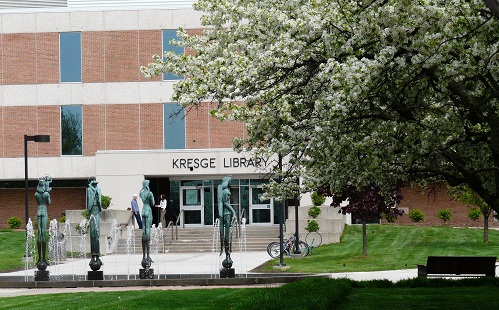
Zee
Michael Todd
Painted steel 12' x 12' x 6'
1977
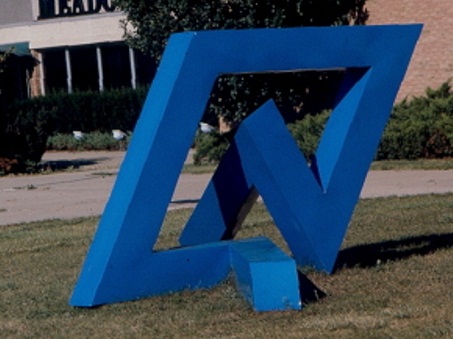
Zee, by Michael Todd, was donated by Mr. and Mrs. Leonard Kasle in 1977.
Charlotte Stokes, an OU Art History professor thus described it in an interview for the Oakland press: "The sculpture is bright blue and curls in space like a crumpled letter Z."1
----
References:
1. Charlotte Stokes, "Hall Exhibit Celebrates Outdoor Sculpture," Oakland Press (26 Oct. 1980): G2.
For more information:
Minutes of the Meeting of the Oakland University Board of Trustees, October 4, 1977
Zee, Smithsonian Art Inventory Sculptures on Waymarking
Michael Todd's website
Sunset Cube
David Barr
Painted steel. 15'x15'x15'.
1981
One of the 6 winners of the Invitational.
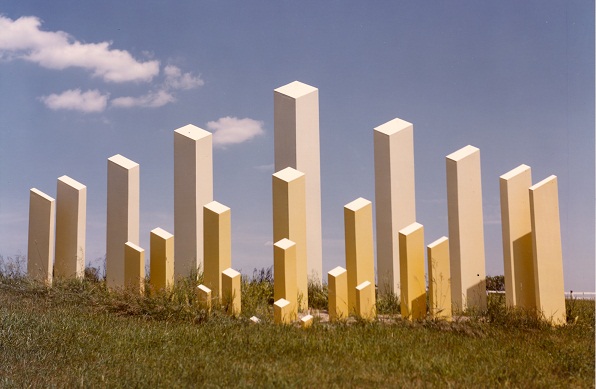
“The sensation of being that it had been there a long time, that the hill had drifted up over it, you know, over a part of it and burying part of it and that part of it had been removed. Then using color also to express that kind of progression of great age.”
Oral history interview with David Barr, 1982 Dec. 28-1983 Jan. 25, Archives of American Art, Smithsonian Institution
David Barr’s Sunset Cube is located on the grounds of the Meadow Brook Festival. It faces west on the hillside at the fork in the road, between the Meadow Brook Hall riding stables and Sunset Terrace.
Barr found his inspiration in the great megaliths of Europe and the play of sun and shadow in the sunset.
He received both his B.F.A. in 1962 and his M.F.A. in 1965 from Wayne State University. From 1965 to 2002 he had a teaching position at Macomb Community College.
His early prominence as an artist in the local community is displayed with commissions for the Fairlane Town Center in Dearborn, the campus of Macomb Community College, and in Detroit, at the Renaissance Center.1 His work can also be seen nationally, and internationally.
Sunset Cube, along with Barr’s Structurist Sculpture No. 11, were donated by George and Barbara Erb.
----
References:
1. Kiichi Usui, "Meadow Brook Invitational: Outdoor Sculpture," Meadow Brook Music Festival Program (1981): 43-50.
For more information:
David Barr, David Barr: Reliefs and Sculptures (Birmingham, Mich. : Donald Morris Gallery, [1984])
Oral history interview with David Barr, 1982 Dec. 28-1983 Jan. 25, Archives of American Art, Smithsonian Institution
David Barr's website
Day Star
Sydney Atkinson
Painted steel
1981
One of the 6 winners of the Invitational.
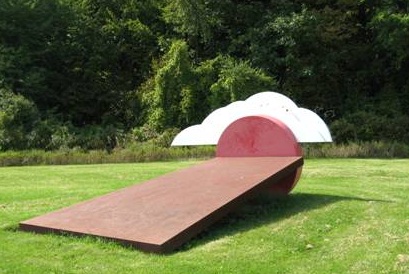
Day Star is the work of artist Sydney Atkinson. Atkinson grew up in Georgia and completed his B.F.A. in sculpture at the Atlanta School of Art. He moved to Michigan and studied at Cranbrook Academy of Art with the Head of the Sculpture department, Michael Hall, where he completed his M.F.A.
Day Star evokes a long, straight highway with sun and cloud on the horizon -- a perspective motorists are like to have on the highway. It was sponsored by a Flint company, Skyline Structures, a division of Anderson "Safeway" Guard Rail Corporation.1
----
References:
1. Kiichi Usui, "Meadow Brook Invitational: Outdoor Sculpture," Meadow Brook Music Festival Program (1981): 44.
For more information:
Sidney Atkinson's website
Day Star, Smithsonian Art Inventory Sculptures on Waymarking
Rhythm and Variations
Hanna Stiebel
Aluminum
1981
One of the 6 winners of the Invitational.

“She was a dancer originally. She tried to capture the sense of rhythm.”
Kiichi Usui, quoted in Jay Jackson, “Artscape,” OU Magazine (Fall 1993): 20-23.
The only female included in the winners of the Meadow Brook Invitational sculpture competition was Hanna Stiebel. Born in Israel, she came to the United States to study in New York with Martha Graham. After Stiebel completed an undergraduate degree Martha Graham encouraged her to express her creative energies in visual art. She then attended the New School for Social Research in New York, and moved to Michigan to attend Cranbrook Academy of Art, where she completed both a B.F.A. and M.F.A. She continued post-master work at Wayne State University and the University of Florence in Italy.
Rhythm and Variations was a commission by Mr. and Mrs. James Fitzpatrick, with the materials supplied by the Reynolds Aluminum Company. Fabrication was done in Pontiac, at Oakland Welding Industries.1
Stiebel has done several other pieces in Michigan.2
----
References:
1. Kiichi Usui, "Meadow Brook Invitational: Outdoor Sculpture," Meadow Brook Music Festival Program (1981): 50.
2. See Dennis Alan Nawrocki, Art in Detroit Public Places (Detroit: Wayne State University Press, 2008, p. 19).
For more information:
Rhythm and Variations, Smithsonian Art Inventory Sculptures on Waymarking
Untitled - Tom Bills
Tom Bills
Cement
4 cubes. 32"x22"x19"
1981
One of the 6 winners of the Invitational.
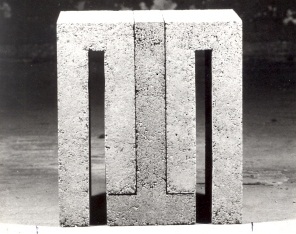
“This is an example of minimalism or the maximum reduction process of modern art.” --
Tom Bills, quoted in Jay Jackson, “Artscape,” OU Magazine (Fall 1993): 23.
Tom Bills was a Michigan native and an Oakland University alumnus. He graduated from Oakland in 1974, and went on to study in New York in the Whitney Independent Study Program in 1975. He then completed his M.F.A. in 1978 at Yale University's School of Art. Bills was also a National Endowment for the Arts grant recipient in 1980-1981 (Usui 46).
These cement pieces were sponsored by the Shuert Industries of Troy.1
Since his work has been on display on campus, Bills has continued to be exhibited locally, nationally and internationally. In 2000, he was awarded a Guggenheim fellowship. He is represented by the Don Sokor gallery in San Francisco
Currently, Bills teaches at the University of California at Davis.
----
References:
1. Kiichi Usui, "Meadow Brook Invitational: Outdoor Sculpture," Meadow Brook Music Festival Program (1981): 46.
Telegraph Exchange, Midwest Sweep Series
John F. Piet
Painted steel. 24'x12'x20'
1981
One of the 6 winners of the Invitational.

As one who grew up in the industrial Midwest, powerful influences came from the character of the streets, factories and the music of Detroit. It is here where I can draw ideas from a wealth of technology and raw materials, essential in providing my art with material and inspiration.
John F. Piet III, Statement of Intent
Born in Detroit, a well-known and long-standing member of Detroit's art scene, John Piet did this sculpture for the Meadow Brook Invitational in 1981. He earned his B.F.A. from the Center for Creative Studies in 1972, then known as the Detroit Society of Arts and Crafts, and completed his M.F.A. at Wayne State University a year later.
Telegraph Exchange was sponsored by the J&J Burning Company, the Budd Company and the Gale Group. They sponsored the fabrication, materials, and installation assistance, respectively 1
Piet has a long list of national accolades and has been honored internationally as well.
----
References:
1. Kiichi Usui, "Meadow Brook Invitational: Outdoor Sculpture," Meadow Brook Music Festival Program (1981): 48.
For more information:
John Piet's website
Untitled
Leiserowitz, Mel.
Painted steel. 15' tall.
1981
One of the 6 winners of the Invitational.

This untitled work by Mel Leiserowitz, then a Professor of Sculpture at Michigan State University, was part of the Meadow Brook Invitational.
Leiserowitz made a career change from journalism, public relations and entrepreneurship before dedicating himself to sculpture in the late 1950s. He earned his Master's degree in 1964 from the University of Iowa.1
Leiserowitz’s works are geometric and concerned with balance, symmetry and color.
The sculpture was made possible by the Kasle Steel Company of Dearborn.
----
References:
1. Kiichi Usui, "Meadow Brook Invitational: Outdoor Sculpture," Meadow Brook Music Festival Program (1981): 46.
For more information:
Mel and Nancy Leiserowitz's website
Motherswell
Joseph Wesner
Painted steel
1988
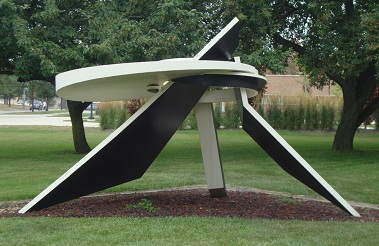
Joseph Wesner, a local artist, has two outdoor sculptures located on campus: Motherswell and Echo Cognitio.
Motherswell was moved from the Center for Creative Studies and installed in front of South Foundation Hall in September of 1988. In 2020, it was restored and moved to the front of Oak View Hall. It evokes "the continuation and celebration of the values and history of the family unit and its central figure." It is the "expression of the idea of maternity."1
The sculpture was donated by a number of people including the artist and the Hill Gallery of Birmingham.2
Wesner was educated at Georgetown University in Washington, D.C., and at Cranbrook Academy of Art. He was an assistant to Meadow Brook Art Gallery Curator Kiichi Usui. Before his untimely death, he was the Chair of the Sculpture department at the Center for Creative Studies.3
----
References:
Quoted in "New Sculpture Installed Near South Foundation," OU Magazine (Fall 1988): 7 .
2. Christina Fuoco, "Artist Donates Sculpture," The Oakland Post (Sept. 12, 1988): 2.
3. "Joseph Wesner at Mid-Career," Press release, 1996, Meadow Brook Art Gallery records, Oakland University Archives.
For more information:
Motherswell, Smithsonian Art Inventory Sculptures on Waymarking
The Burghers
David Scott
Cor-Ten steel
1994
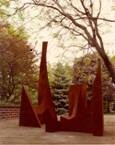
The Burghers was originally installed in front of the Oakland Center, in between North and South Foundation Halls, but now resides in the courtyard of Wilson Hall.
For more information:
Sarah Wojcik, "Oakland University campus filled with meaningful sculptures," Oakland Press (November 27, 2011)
Structurist Sculpture No. 11
David Barr
1994
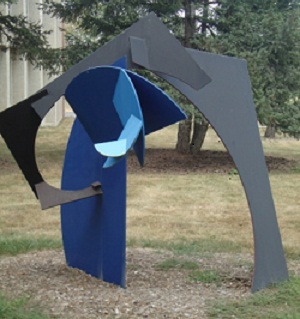
Structurist Sculpture 11 was originally installed in the high traffic area in front of the Oakland Center, in between North and South Foundation Halls.1 It now resides in the courtyard of Wilson Hall, in the Varner Memorial Garden, like David Scott’s The Burghers.
----
For more information:
----
References:
1. Jay Jackson, “Artscape,” OU Magazine (Fall 1993): 20-23.
Echo Cognitio
Joseph Wesner
Cor-Ten steel
1999

"The sculpture has to do with understanding and wisdom flowing around like the curves of the building. It symbolizes the recurring cycles of human vision, imagination and knowledge."
Brian Murphy, Honors College Director (quoted in "The Finishing Touch," Inside Oakland (Nov. 1999): 4)
A donation to the Honors College by Ann and Jim Nicholson, Echo Cognitio was installed in front of the College's entryway in Vandenberg Hall. When the Honors College moved to the new Oak View Hall in 2014, Echo Cognitio followed it there. The title of the scupture - “echo of knowledge” in Latin - is well suited for the Honors College. Ann Nicholson, vice chairwoman of the Board of Trustees, hoped that the work would become a symbol of the Honors College's "unique identity" and that "it [would] give a lot of pleasure to Oakland students for generations to come."1
This was the second sculpture of Joseph Wesner on campus, following his Motherswell.
Wesner has said of his art: "Meaning is the essential concern in my sculpture. Within the parameters of welded and painted steel I attempt to create sculptures that affirm the celebration of life . . . It is [the] search for the essence of life's celebrative joy as shared in the creative experience to which my sculptures aspire."2
----
References:
1. "The Finishing Touch: Echo Cognitio," Inside Oakland (Nov. 1999)
2. Sarah Wojcik, "OU Campus Filled with Meaningful Sculptures,” Oakland Press (Nov 28. 2011)
Resound
Sharon Que
2002
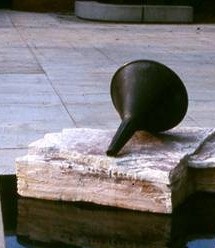
Resound was installed in the Varner Memorial Garden in 2002.
Sharon Que is a native Detroiter. Her first art instructor in college was John Piet, whose work Telegraph Exchange is also on the OU campus.1
After graduation from the University of Michigan with her B.F.A, Magna Cum Laude, in 1982, she earned an Associate's Degree in 1986 from Macomb Community College in Manufacturing Engineering.2 While working in the skilled trade of wooden model making at GM, she was also establishing herself as an artist.3
Resound was the largest work Que ever attempted.4
Que said about Resound: "I would like to think of ‘Resound’ as representing an ongoing communication. Communication in education and a balanced dialogue between man and nature, one flowing into the other without one claiming power. Communication which aids in a transformation — a subject every educator is involved with. The result of what goes in is not a replication of what comes out.”5
----
References:
1. Dick Goody, " Sharon Que Interview, " Retrofit (exhibition catalog, Meadow Brook Art Gallery, 2003), 4.
2. Dick Goody, " Sharon Que Interview, " Retrofit (exhibition catalog, Meadow Brook Art Gallery, 2003), 23.
3. Dick Goody, " Sharon Que Interview, " Retrofit (exhibition catalog, Meadow Brook Art Gallery, 2003), 5.
4. Dick Goody, " Sharon Que Interview, " Retrofit (exhibition catalog, Meadow Brook Art Gallery, 2003), 21.
5. “Ground Broken for New Parking Structure,” OU News (April 18, 2002)
The Grizz
Istva'n Mate and Gyorgi Lantos
Bronze
2006

The Grizz is the work of Hungarian sculptors Istva’n Ma’te and Gyorgyi Lantos, parents of an OU student and swimmer, Hunor Ma'te. World-renowned sculptors, Istva’n Ma’te and Gyorgyi Lantos agreed to make the grizzly for the price of materials and shipping. The money came from OU Student Congress, the Division of Student Affairs, the Department of Athletics and the President’s Office.1
Their sculpture has been adopted as Oakland University's mascot, the Grizz. Unveiled in September of 2006, the bronze sculpture weighs nearly one ton and stands eight feet tall.2
----
References:
1. "Grizz Statue Unveiling Set for Sept. 6," OU News (August 28, 2006)
2. "Center for Champions, Grizz Statue Unveiled," OU News (September 11, 2006)
For more information:
The Grizz on Waymarking.com
Istva’n Ma’te and Gyorgyi Lantos website
OU Magazine (Fall 2006)
The Meadow Brook Invitational: Outdoor Sculpture Competition (1980)
Six sculptures stand on the eastern campus grounds nearest Meadow Brook Hall and what has become the Meadow Brook Festival ground. Their existence is the result of the Invitational Outdoor Sculpture Competition.
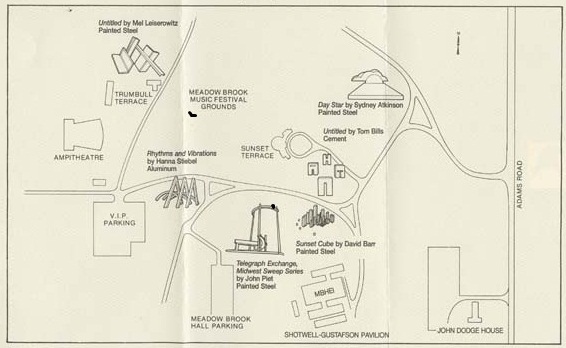
Source: Kiichi Usui, "Meadow Brook Invitational: Outdoor Sculpture,"
Meadow Brook Music Festival Program (1981): 43.
Made up of influential supporters of the community, the Meadow Brook Gallery Associates envisioned furthering the school's impact on the community. In 1980-1981 they worked with Kiichi Usui, the Curator of what was then called the Meadow Brook Art Gallery (now Oakland University Art Gallery) to create a competition for Michigan sculptors, named the Meadow Brook Invitational: Outdoor Sculpture Competition.
The aim was three-fold: to show the works of new or veteran artists to a large audience;1 to create more visual interest in the environment;2 and to serve as fundraising tools for the University and the Art Gallery. The sculptures are situated prominently at entrances to campus, near the VIP parking lot and the grounds of the Meadow Brook Music Festival, and on the grounds of Sunset Terrace.
In January 1980 600 invitations were sent to sculptors in the Michigan Art Registry. There were 76 applicants among whom 14 semi-finalists were selected. The semi-finalists exhibited scale models, or maquettes, in the Oakland University Art Gallery for the public to view. After the exhibit, these maquettes were photographed on their proposed site of the Meadow Brook Festival grounds, so as to provide a more accurate visual representation of the impact of each work. Six winners were then chosen to have their visions realized with the help of sponsorship from area corporations.3
Contracts were drawn by which each of the six works would be on loan from the artist for a period of three years. This period of time was designed to allow for individuals or corporations to purchase the works for their private enjoyment or donation to a public institution.4 Unfortunately, an economic recession slowed down the project. By 1986 enough grant money and donations were raised to transfer the title of the sculptures from the artist to the University.5
The Meadow Brook Art Gallery Associates has been instrumental in bringing not only the sculpture onto campus, but helping fund all of the exhibitions at the gallery and making a name for Oakland University in the art world.6 Their backing of the Meadow Brook Invitational I: Sculpture exhibit made headlines nationwide in art circles and has elevated local artists to become nationally known. It led to a second invitational, specifically for painters.
Despite the never-ending quest for funds in the arts community, the impact of Oakland's Meadow Brook Invitational I: Sculpture was positive -- the idea spread to other scholastic institutions and neighboring communities. Louis Redstone, an architect and author, hosted a project similar to the Invitational with the City of Southfield and the Business Consortium for the Arts in both 1987 and 1989.7 Redstone is the architect who designed Hamlin Hall, Pryale House and Anibal and Fitzgerald Halls on campus.
Oakland's sculpture park was even named "The Best Surreal Setting" and appeared in the list of the The Very Best of Detroit compiled by Metropolitan Detroit Magazine in February 1985.8
----
References:
1. Marion Handleman, " Foreword," Meadow Brook Invitational II: Painting (1983), 1. Meadow Brook Art Gallery records, Oakland University Archives.
2. Kiichi Usui, "Meadow Brook Invitational: Outdoor Sculpture," Meadow Brook Music Festival Program (1981): 50.
3. Kiichi Usui, "Meadow Brook Invitational: Outdoor Sculpture," Meadow Brook Music Festival Program (1981): 43.
4. Kiichi Usui, "Meadow Brook Invitational: Outdoor Sculpture," Meadow Brook Music Festival Program (1981): 50.
5. Executive Board of Directors, Meadow Brook Gallery Associates, Meeting minutes, 19 Aug. 1986. Meadow Brook Art Gallery records, Oakland University Archives; "University Buys Sculptures," OU News (January 17, 1986): 2.
6. Nancy E. Ryan, "Art A La Barron: Anniversary Exhibit Honors Meadow Brook Art Gallery Patrons," Oakland University Magazine (Fall 1984): 11-12.
7. Louis G. Redstone and R. Thomas Ossman, to undisclosed business and community leaders, 10 Nov. 1988. Meadow Brook Art Gallery records, Oakland University Archives.
8. "The Very Best of Detroit," Metropolitan Detroit Magazine (Feb 1985): 61.
2018: Matilda Dodge Wilson
Lou Cella
bronze
2018
Image courtesy of Benjamin Fielder
The life-sized, bronze statue of Oakland University founder Matilda Dodge Wilson was unveiled during Homecoming 2018, on October 6. The statue was placed between the Oakland Center and South Foundation Hall, 2 of the first 3 buildings of the university. It honors the central role that Matilda Dodge Wilson played in the founding and early years of what was then "Michigan State University Oakland."
The statue was commissioned to Chicago-area sculptor Lou Cella, who used photos of Matilda Wilson to make the statue true to life. Cella has created notable statues across the United States as well as locally. Thus he made statues of Ernie Harwell, Al Kaline and other Detroit Tigers baseball players featured at Comerica Park.
In providing access to its collections, the Oakland University Archives and Special Collections acts in good faith. Despite the safeguards in place, we recognize that mistakes can happen. If you find on our website or in a physical exhibit material that infringes on an individual’s privacy, please contact us in writing to request the removal of the material. Upon receipt of valid complaints, we will temporarily remove the material pending an agreed solution.




